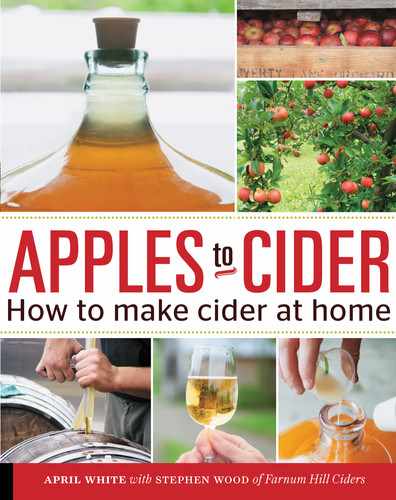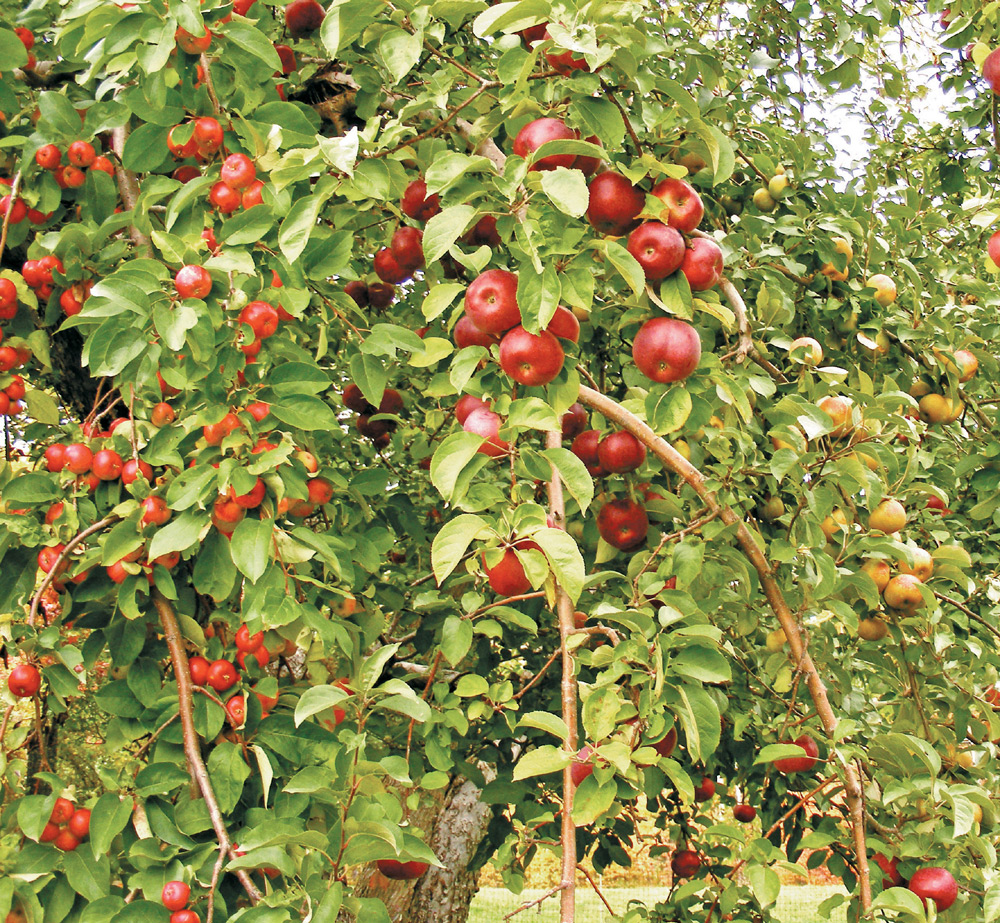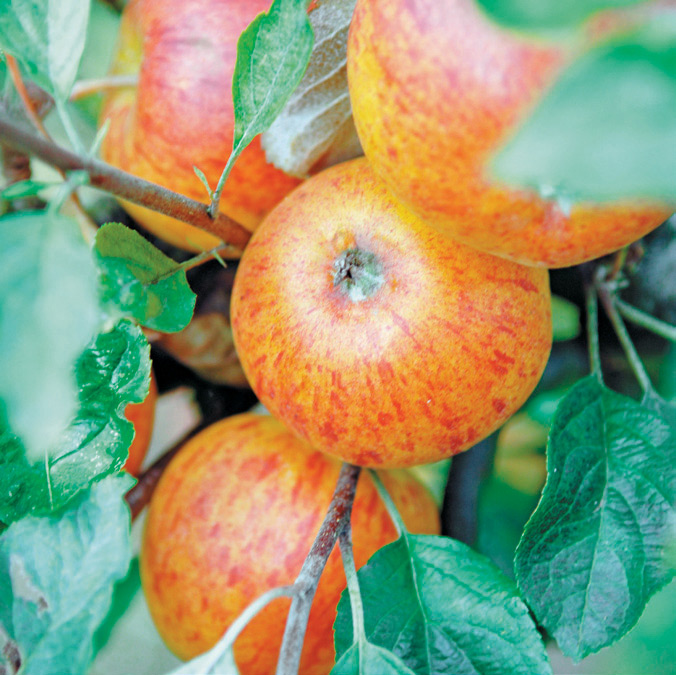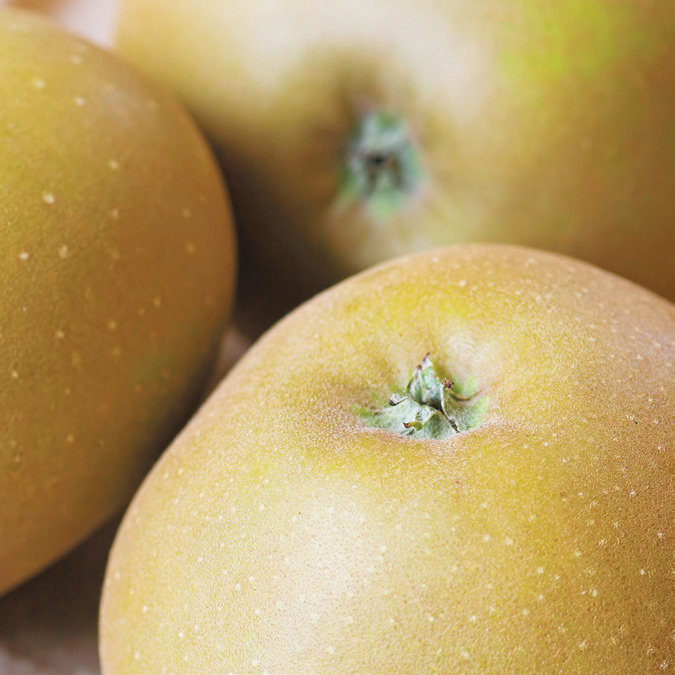CHAPTER 3
Starting with Apples
Cider begins in the orchard. Very few home cidermakers pick and press their own apples, and even fewer grow their own apples, so you might be tempted to skip this chapter. Don’t. Home cidermakers who will buy the juice for cidermaking from an orchard still need to understand the apple. Apples are the main—and some would say the only—ingredient in cider.
Buy the highest quality juice you can find for your home cidermaking. That’s the best advice you can get about cidermaking. The difference high-quality ingredients will have on the finished product is dramatic. Don’t buy apple juice in the supermarket to make cider. Overlooking issues of quality, store-bought juice often has additives that make fermentation difficult or impossible.
IN THE ORCHARD
Every decision an apple grower makes—from what varieties of apple trees to plant to how close to plant those trees to one another—affects the fruit that the trees produce and the cider that you can make from them.
For that reason, smaller orchards focused on growing cider apples look very different from commercial orchards growing dessert apples, as apples designed for eating are called. Commercial orchards growing dessert apples often plant small trees very densely, with as many as 1,000 trees per acre (0.4 ha). The trees, often irrigated, are flanked by grassless strips of dirt that allow more water and nutrients to flow to the trees and prevent pests, and the apples are picked from the tree before they achieve complete ripeness, with the prettiest apples fetching the highest prices.
It is often said that the bin of apples that looks the worst is worth the most. Cider apples are not judged on the same criteria as dessert apples. Apples don’t have to be attractive or consistently sized to have a great flavor.
In the bittersweet cider apple orchards at Poverty Lane, apples are grown on big trees, planted just 200 trees to the acre (0.4 ha), and grass flanks the trees. The orchard looks like the classic New England farm that it is, but these decisions serve an apple-growing purpose. For instance, the grass provides a soft landing for the cider apples, most of which are picked off the ground.
When growing cider apples you are looking for extremely ripe fruit, just on the edge of rot. The texture of the apple may be soft or chewy, but that isn’t a concern in a process that involves pressing the apples for the juice. For the cidermaker, the key is picking apples after all the fruits’ starch has been converted to sugars.
Spring in the Orchard
Making a batch of cider is, in truth, a yearlong process. The process begins in late winter or early spring as the apple trees, which have been dormant for the winter, begin to awaken. As the weather begins to warm, the tight, scaly buds of the winter apple tree begin to swell in anticipation of spring.
At the orchard, the winter and early spring are a time to prune the trees, grooming them for a fruitful growing season. As the days grow warmer and the ground thaws, the pruning brush is turned into mulch to nourish the soil and the trees. New apple trees are also planted in the first days of spring; it will be several years before those new trees produce an apple crop. Some varieties will produce a good crop in the third “leaf,” or year; others won’t produce a full crop until the eighth leaf.
Spring is a time of rapid change in the apple orchard. First, the long-dormant trees develop a light gray fur on their scaly buds. This is known as “silver tip.” Next, the trees show “green tip,” a tiny sliver of green on the buds. A few days later, you will see “quarter-inch (6 mm) green” and then “half-inch (1.3 cm) green,” as the buds continue to grow. If you look closely you will see that each flash of green is a cluster of four or five buds gathered tightly around a central bud. If you were to dissect one of the buds, you would see flower organs developing.
For the apple growers—particularly ones who practice a minimal-intervention approach to pest management—observing the orchard carefully is key. It’s important to understand how the weather and other environmental factors are affecting the trees, and to watch out for signs of pests or other enemies of the orchard that might affect the season’s burgeoning crop.
Next, the trees begin to produce leaves. “Mouse ear” is the term for the moment the first tiny green leaves pop out. They do resemble mouse ears. Next, the “tight cluster” of buds separates slightly. This is called “floret separation.”
The progression of an apple tree’s growth through a gently warming spring is predictable, but no less dramatic for that. Shortly after “floret separation” comes “king pink,” when the center bud cracks, revealing a hint of pink. Depending on the weather, every bud will turn pink within a day or two, a stage known as “full pink.” The surest sign that spring has arrived comes shortly thereafter, when the center bud blooms, “king blossom.” Within a week, the apple orchard will be awash in blooms, a beautiful moment known as “full bloom.”
This is a critical moment for the apple trees, which must be pollinated to produce apples. Bees and other insects attracted by the nectar of the apple blossoms spread the pollen from tree to tree; most apple trees are not self-pollinating, which means they must receive pollen from another apple tree, not simply from another flower on the same tree. Apple growers hope for sunny, fair weather during full bloom. Rain and wind can damage the blossoms and discourage the bees and other insects.
After this period of pollination, the trees lose their bloom—“petal fall”—and tiny apples, just an eighth of an inch (3 mm), begin to form. If you dissect these tiny fruits, you can see their developing seeds, a sign that pollination occurred. If pollination has not occurred, the tiny fruit will simply fall from the tree.
Summer in the Orchard
As the trees begin to produce apples, some will fall from the tree. This is the tree deciding how many apples it can support for the season. The apple grower often intervenes in this process. Frequently, an apple grower will further thin the crop to ensure the tree can produce high-quality, and not just high-quantity, fruit. The apple grower also has ways to encourage a larger crop from trees that are under producing. A tree that is strategically damaged will often be shocked into producing more apples.
Through the summer, the orchardist is on careful watch to prevent or eradicate pests, from apple scab to deer. Many apple growers will run leaf and soil tests to evaluate when the trees should be fertilized. And there is always mowing and pruning to be done.
Warm and sunny summer days with the occasional soaking evening rain are the apple growers’ ideal through the summer months. Passing afternoon thundershowers are their nightmare. Extreme conditions during a thunderstorm, especially hail, can damage trees, but the bright sunlight that comes after the storm, intensified through the magnifying-glasslike lens of each raindrop, is also a danger, threatening heat damage.
Fall in the Orchard
As the summer days shorten into fall, the apple grower hopes for drier weather and a slow and steady temperature decline. The wish for drier weather is for the apple growers’ well-being as well as for the trees’: Harvest comes with many outdoor chores.
The size of the harvest depends on innumerable variables, but the weather is key. No season is ideal, but the hardest seasons for the apple grower and the apple trees are ones with extreme temperature changes or weather events. Nothing confuses a tree more than a stretch of warm days in the middle of winter or a cold snap in July.
Cider apples are most often picked from the ground. The apples fall from the tree at the peak of ripeness and those that don’t release their hold as easily are loosened with a gentle tap to the tree with a long pole. A tree is picked several times over the course of a week to ten days; each time the pickers, working by hand, take only the ripest fruit.
In American cider orchards, most apples are picked by hand. In European cider orchards, harvest is more often mechanical. One machine shakes the trunk of the tree, sending the apples to the ground, and another collects the apples.
Different apple varieties mature at different rates, so picking can occur from the early fall through the late fall. Because Poverty Lane Orchards is located in the cold climates of northern New England, this can mean that the late-harvest apples are exposed to temperatures well below freezing during the nights. Cidermakers who work with this type of fruit believe that these frosts—but not a deep freeze—improve the fruit.
Winter in the Orchard
When the deep freeze comes, the work in the orchard comes to a halt. The trees prepare for hibernation, throwing off their leaves and developing a scaly covering to protect the buds. There is plenty of winter pruning to be done, but in the cider orchard the attention turns from the apple trees to the cider room.
THE APPLE
The apple tree produces apples for the purposes of spreading the apple seeds hidden inside the fruit. In a natural environment, the sweet fruit attracts animals that eat and excrete the seeds. The cidermaker interrupts this process, taking the apples for the purpose of cidermaking, not seed distribution.
Most home cidermakers start the cidermaking process with juice, but a basic understanding of the terms used to describe apples can be helpful. When talking about apples, apple growers most often consider the size—apples can range in size from tiny 3/4-inch (2 cm) fruit to 33/4-inch (9 cm) fruit—shape, skin, and flesh of the apple.
An apple’s shape is often described as conical (tall and tapered from the shoulders, or stem end, to the calyx, or bloom end), cylindrical (tall and untapered) or flat (more broad than tall). Shape is typically a lesser concern for cidermakers.
The skin of an apple contains some of the flavor, aromas, and other compounds that will make their way into the juice and the cider. The skin can be described by feel (smooth or rough, dry or oily), thickness (thick or thin) and, most often, color. Apples start their growing life as green fruit and then develop a variety of colors from green to yellow, orange, and red. Apples are often described has having a background or “ground” color and a surface or blush color. This combination of colors can give apples a striped, splotched, or streaked appearance. Some varieties of apples are also described as being “russeted,” which means they have a brownish, leathery layer on the skin. The color of the skin does not affect the juice and cider, but the tannins and other compounds present in the skin can shape the cider.
The flesh of a ripe apple contains most of the flavors, aromas, and other compounds, such as tannins and acids, that will be found in the pressed juiced and the fermented cider. The texture of the flesh can be described as fine grained (sometimes considered “greasy” in pressing) or grainy (which can be “dry” in pressing). Its flavors, and the acids and tannins, can be described in numerous ways. (See chapter 2.)
A SAMPLING OF APPLES
Because apples are an agricultural product, where and how the apples are grown can have a big impact on their taste and texture. You won’t find all of these apples—or these exact apple characteristics—in your region, but this sampling will give you a taste of the apples grown by Farnum Hill and other leading cidermakers around the world and how they are used in cidermaking.
Typically, cidermakers mix the juice of several apple varieties harvested around the same time before beginning fermentation. Only a few varieties have all the necessary characteristics to produce a balanced cider on their own.
When cidermakers talk about apples, they often divide them into two loose, unofficial categories: cider apples and commercial apples. The first category is for those apples that are grown primarily for cidermaking. The home cidermaker usually has to seek these apples out from small, local producers, but the effort is rewarded with more nuanced, balanced cider. Commercial apples are more easily accessible to the home cidermaker; commercial apples are often divided into dessert or eating apples and baking apples. Although many common apples are not suited for cidermaking, varieties such as Golden Delicious, Idared, and Jonathan are widely available. These apples have properties which make them a reasonable stand-in for more traditional cider apples. Taste the apples to evaluate their usefulness in cidermaking.
Cidermakers divide “cider apples” further into categories that describe their main characteristics: bittersweet, which provide tannins; bittersharps, which provide both acid and tannins; sweets, which provide flavor and aroma; and sharps, which provide acid.
If the exact varieties listed below aren’t widely grown in your region or did not produce a large crop this season, don’t despair. If you think about balance and select apples that will provide the necessary sugars, acid, tannins, and flavors you can create a good cider from the available fruit.
As a note: Both early- and late-season apples can produce delicious, balanced cider. However, early-season apples tend to produce ciders with lower alcohol content than late-season apples.
Bittersweet Cider Apples
Bittersweet apples provide a cider’s structure. Their tannins can make them unpleasant for eating out of hand, but those same tannins provide the underpinnings for a good batch of cider. Tannins are responsible for the astringent and bitter characteristics in cider. Generally, cidermakers are looking for two types of tannins: soft tannins, such as those found in Yarlington Mill, and harsher tannins, such as those found in Dabinett. Bittersweet apples are low in acid, so they are blended with other, more acidic apples to create a balanced cider.
Ashton Bitter
A popular early-season apple in England in the 1970s and ’80s, Ashton Bitter has a squashed, conical shape with orangey-red stripes on a yellow background. The Ashton Bitter apple tree does not produce the sizeable crops needed for large-scale commercial cidermaking, but has value for small-batch cidermaking.
Apple flesh: A balance between fine-grained and grainy, under a thick skin
Apple flavor: Very harsh tannins, with only a faint apple taste
Use in cidermaking: Harsher tannins in early-season cidermaking
Chisel Jersey
Like Dabinett, Chisel Jersey is an old English variety. Some believe the two apples to be related. Chisel Jersey has a similar shape and coloring and ripens at the same time, but its tannins are even more aggressive than the harsh Dabinett tannins.
Apple flesh: Somewhat grainy
Apple flavor: Direct, astringent tannins with leather and citrusy fruit flavors in the background
Use in cidermaking: Harsher tannins. (Surprisingly, though, the juice of the Chisel Jersey is less tannic than the apple, and after fermentation more fruity flavors emerge.)
Dabinett
This old English bittersweet originated in Somerset County in the early 1900s. Today, the cold-hardy apple remains a mainstay of traditional English ciders. The slightly flattened orange- and red-striped apple is hard to eat, but its notably harsh tannins are exactly what make it a popular cider apple.
Apple flesh: Somewhat grainy; can be dry when pressed
Apple flavor: The first thing that strikes you is hard tannins, bitter and astringent, followed by leather and apple flavors.
Use in cidermaking: Prized for its tannins; a workhorse apple for Farnum Hills’ late-season ciders
Ellis Bitter
Held in high regard by cidermakers as a versatile apple, Ellis Bitter traces its origin to nineteenth-century England. To the untrained eye, the conical, orange-red apples resemble Major apples.
Apple flesh: A balance between fine-grained and grainy
Apple flavor: Middle-of-the-road tannins
Use in cidermaking: A good all-purpose apple that keeps well, often used to balance early fermentations
Harry Masters Jersey
A conical, pale red, English apple, sometimes called Port Wine, Harry Masters Jersey resembles Yarlington Mill in flavor and use. It matures earlier in the season than Yarlington Mill.
Apple flesh: Fine-grained; the apples mill easily, but can be loose or “greasy” in pressing
Apple flavor: Similar to Yarlington Mill with soft tannins
Use in cidermaking: Softer tannins in early- to mid-season cidermaking
Major
Commonly found in old farm orchards of Devon and south Somerset, these English apples have soft tannins often used to balance the hasher tannins of many bittersweets.
Apple flesh: A balance between fine-grained and grainy; presses easily
Apple flavor: Soft, round tannins and fruity characteristics
Use in cidermaking: Softer tannins in early-season cidermaking
Medaille d’Or
A late blooming but early ripening French apple, Medaille d’Or has a tough golden yellow skin covered in brown russet. The apple is tiny, but the tannins are huge.
Apple flesh: Grainy
Apple flavor: So bitter and astringent as to make other bittersweet apples seem mild in comparison
Use in cidermaking: Extremely harsh tannins in early-season cidermaking; used sparingly
Somerset Redstreak
For apple growers, Somerset Redstreak is a frustrating biennial variety. A plentiful crop one season promises a scarce one the next. The beautiful, small, red apple should not be confused with the older, similarly named Redstreak, a bittersharp variety.
Apple flesh: A balance between fine-grained and grainy
Apple flavor: Although the tannins can vary based on growing conditions, they are usually softer.
Use in cidermaking: Beautiful, softer tannins in early-season cidermaking
Yarlington Mill
Another classic English cider apple, Yarlington Mill has been a popular blending apple for more than a hundred years. The reddish-pink apple is tall, tapering toward the calyx. Yarlington Mill apples have softer tannins than many bittersweets, which means the apples have a less aggressively bitter bite when tasted.
Apple flesh: Fine-grained; the apples mill easily, but can be loose or “greasy” in pressing
Apple flavor: Soft, round tannin with subtle fruit flavors and less leathery flavor than many bittersweets
Use in cidermaking: Softer tannins in mid- and late-season cidermaking; Farnum Hill often blends Yarlington Mill with the more harshly tannic Dabinett.
Bittersharp Cider Apples
Bittersharp apples are high in both acid and tannins, though the tannins are typically not as aggressive as those found in bittersweet apples.
Foxwhelp
The name Foxwhelp dates to the 1600s, but it’s unlikely that cidermakers today are fermenting the same Foxwhelp apples as their English forerunners. In the intervening centuries, the name has been applied to numerous varieties of apples, including H. P. Bulmer’s Improved Foxwhelp.
Apple flesh: The most common modern variety is a large apple with soft flesh.
Apple flavor: The green apple with red stripes has less astringency and bitterness than many bittersharps.
Use in cidermaking: The mid-season apple can be useful in blending.
Kingston Black
Kingston Black is notable for being one of the few cider apples grown today that will make a delicious cider all on its own. The small, deep red apple, which originated in England’s Somerset County in the nineteenth century, has a balance of sugar, tannins, and tartness.
Apple flesh: Moderately grainy; easy to press
Apple flavor: Considered by some to be an edible apple, with structured, but not harsh tannins and a light sourness
Use in cidermaking: Often fermented by itself, producing a barely acidic cider with reasonable tannic underpinnings
Redstreak
Like Foxwhelp, the English Redstreak apple is a subject of much lore and confusion. Centuries-old cider texts describe an ideal cider apple, with all the attributes necessary for creating a well-balanced, single-variety cider. For years, cidermakers have searched for that apple. Today’s Redstreak has red streaks on a yellowish-green background, but it is a small, unexceptional bittersharp used in blending.
Apple flesh: Mushy when ripe
Apple flavor: Nice, round acidity with some tannic structure
Use in cidermaking: For early season blending. Redstreak can add acid without adding significant flavor.
Stoke Red
Apple growers don’t love Stoke Red—the trees are notoriously tricky to grow—but cidermakers are fond of the small, flat, orange-and-red striped apples, which originated in Somerset County, England. Stoke Red are no longer planted widely but, unlike many bittersharps, the current variety is believed to be unchanged from the one cidermakers used a century ago.
Apple flesh: Somewhat grainy; mushy
Apple flavor: Very strong with dominant acidity and harsh tannins
Use in cidermaking: A wonderful source of acid in mid-season blends; produces a low- to medium-alcohol cider.
Sharp Cider Apples
When fermented, sharp cider apples create cider with bright acids and flavors from herbs to fruit to flowers.
Ashmead’s Kernel
An old English cider apple that thrives in North America, Ashmead’s Kernel is also delicious for eating, with an abundance of fruity and floral flavors. The apple is classically beautiful, round with a flowery calyx and a textured brown russet over an orange-yellow background.
Apple flesh: Very grainy
Apple flavor: The apple’s fruity and floral flavors and acid–sugar balance produce a high-alcohol, high-acid cider with rose-like aromas.
Use in cidermaking: Fermented on its own for blending. The finished cider provides floral, fruity acid to late-season blends.
Esopus Spitzenburg
Esopus Spitzenburg originated in Ulster County, New York, in the eighteenth century. The slightly conical, orange-red apple was reputedly a favorite of Thomas Jefferson, who tried, but failed, to cultivate the apple at his home in Virginia. Unlike many cider apples, “Spitz,” as it has been nicknamed by fond cidermakers, is also good for eating, cooking, and drying.
Apple flesh: Dense; not grainy
Apple flavor: Intense acid balances out high sugar for a rich apple that produces green herblike flavors in fermentation.
Use in cidermaking: Spitz produces a high-alcohol cider that is also high in soft, bright acids, making it a favorite for late-season blends.
Wickson
This tart, red apple was developed on the West Coast for cidermaking. Its small size means that it is rarely grown for eating, but it is a tasty treat fresh as well as in cider.
Apple flesh: Fine-grained; crisp, white, and juicy
Apple flavor: This herbal, spicy apple creates a pale, aromatic, high-acid cider that suggests white grapes.
Use in cidermaking: Fermented on its own for blending. The finished cider provides grapelike acid to mid- and late-season blends.
Sweet Cider Apples
Sweet cider apples are often less coveted than their high acid or high tannin counterparts, but they can add sweet, fruity flavors to cider.
Golden Russet
Golden Russet apples are round with a flowery calyx and a sweet, fruity flavor with acid. For the home cidermaker, Golden Russet may be one of the easiest-to-find fruits that can be fermented alone into a fruity, low-acid cider that develops complexity through maturation.
Apple flesh: Yellow; slightly chewy
Apple flavor: This generically “fruity” apple can produce cider with flavors of peaches, pears, mangoes, and pineapple.
Use in cidermaking: In blending, Golden Russet adds fruit flavors without changing acidity. Can be fermented alone.
TURNING APPLES INTO JUICE
The process of turning apples into juice is a relatively straightforward one: Apples are milled into pomace and then the pomace is pressed to extract the juice. The juice is collected and the pomace is discarded. This process is the same for sweet cider—which can be consumed right off the press—or hard cider, which is then fermented.
There are many different types of mills; some grind the apples while others slice or grate. There are also many different types of presses. At Poverty Lane Orchards, the pomace is pressed in a vertical rack-and-cloth press. The pomace is placed on burlaplike cloth between wooden frames. Slowly, a hydraulic piston rises pressing the pomace. The juice flows out of the pomace, strained by the cloth, and the solids remain behind.
Through the harvest, the orchard’s press can produce 800 gallons (3,028 L) of sweet cider a day. Large commercial presses produce tens of thousands of gallons a day. Regardless of the press used, each bushel of apples (a bushel is about 42 pounds, or 19 kg) produces about three gallons (11 L) of juice. The six gallons (23 L) of juice you will use to make your first batch of hard cider started as two bushels, or 84 pounds (38 kg), of apples.
SOURCES FOR JUICE
For the home cidermaker, finding a source of high-quality juice can be the most difficult part of the cidermaking process. At a minimum, you must start with juice without any additives. Many cidermakers also prefer to use unpasteurized juice (and it is essential for making cider through spontaneous fermentation; see chapter 7) but the sale of unpasteurized cider is regulated.
The key to finding the best juice is asking the right questions. Start by contacting local orchards or home brewing suppliers, which may sell juice from cider apple orchards. Fellow home cidermakers are a good resource for juice sources in your region.
Tell the orchard or home brewing supplier what you are looking for. Because an apple’s availability and characteristics can vary by region or growing season, it’s easier to talk about the qualities you are looking for—a high level of tannins, for instance—than to ask for specific varieties. It can be easy to get caught up in the lore surrounding different types of apples; don’t automatically assume the apples labeled “heirloom” are the best cidermaking apples available. They may not have been bred or cultivated for cidermaking.
If possible try the juice—or the apples—before purchasing six gallons (23 L) for your carboy. You aren’t necessarily looking for delicious juice, so don’t be seduced by the aromatics that are likely to change during fermentation. Instead, evaluate the balance of sweetness and acidity, and look for noticeable tannins.
Most importantly, though, don’t let the quest for the perfect juice prevent you from getting your start as a home cidermaker. Cidermaking is process. Start fermenting with the best juice you can find and continue your hunt for even better juice for the next batch.





















 NOTES FROM THE CIDERY, STEVE WOOD
NOTES FROM THE CIDERY, STEVE WOOD